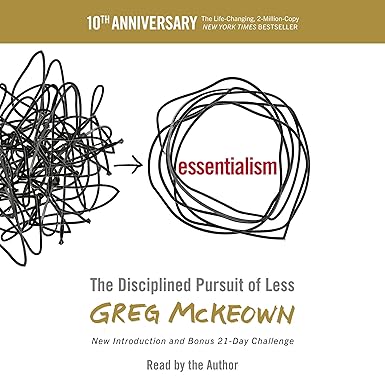
Essentialism: The Disciplined Pursuit of Less
- Master the art of doing less, but better. Essentialism guides you to eliminate the nonessential, focus on what matters most, and reclaim your energy for a more purposeful life.
- Join the Essentialist movement with the New York Times bestseller. Access a 21-day challenge PDF to practice selective criteria and make your greatest contribution on what truly matters.
- Essentialism is widely praised for its practical framework to focus on what matters, but some readers find it overly verbose or lacking novel insights.
- No major safety or authenticity rumors circulate about the book, though occasional binding defects and formatting quirks in digital editions have been reported.
- The most serious complaints center on audience fit—readers cite its business‐centric tone, examples of privilege bias, and occasional gender blind spots.
- Introduces bestseller credentials, core promise, and structure of Essentialism.
Product Overview
Essentialism: The Disciplined Pursuit of Less by Greg McKeown is a New York Times bestseller promising to teach readers “how to get only the right things done.” Released in 2014, it has sold over a million copies and includes a downloadable PDF featuring the 21-day Essentialism Challenge. Structured in four parts—Essence, Explore, Eliminate, Execute—the book blends anecdotes, research findings, and exercises aimed at helping readers discern vital priorities, eliminate nonessentials, and build systems to make essential work nearly effortless.
- Summarizes the book’s promise, structure, and target audience.
Essentialism Review: Honest Findings
McKeown’s core message is that “less but better” yields higher contribution than spreading energy across too many good but non‐vital tasks. He defines an Essentialist mindset based on three assumptions to conquer—“I have to,” “It’s all important,” and “I can do both”—and offers practical tips for saying a slow “yes” and a fast “no.” While many readers applaud its clear, systematic approach, critics point to its occasional lapses into unnecessary storytelling and overlong chapters that could have been trimmed by at least half. Overall, the book stands out as a structured self-help guide rather than a groundbreaking academic work.
- Highlights the disciplined pursuit of less and the “vital few” principle.
Positive Feedback & Highlights
Many professional readers and lifelong learners praise Essentialism for:
- Actionable frameworks: Clear steps to Explore, Eliminate, and Execute priorities.
- Memorable analogies: The wardrobe metaphor crystallizes the process of decluttering choices.
- Engagement tools: Exercises like “What’s Important Now” (WIN) and buffers for decision fatigue.
- Inspirational quotes: “If you don’t prioritize your life, someone else will,” resonates across contexts.
Readers also value its blend of business anecdotes and personal life examples, noting that even Christian audiences can benefit by pairing Essentialism with their own ethos. Others appreciate the challenge to build new routines—from sleep scheduling to “play” breaks—that reinforce long-term focus.
- Details recurring complaints around length, anecdotes, and applicability.
Negative Reviews & Rumor Analysis
While no widespread scandals or authenticity rumors afflict the book, several consistent criticisms emerge:
- Verbose padding: Critics argue up to half the book could be pared without losing core value.
- Audience bias: Some find the tone overly corporate—targeted at executives with staff or “privileged” settings—and not universally applicable.
- Gender and privilege blind spots: Female academics and working parents note that the book assumes uninterrupted work blocks, which are rare for caregivers.
- Formatting and binding issues: A minority report cracked spines, missing pages, or e-book layouts with unresolved footnotes.
- Digital pricing grievance: Several buyers complained about paying full retail for Kindle editions after purchasing print copies.
Rumors of a “cult-like Essentialist community” are unfounded—no secret society or closed group exists. The “Essentialist” label simply serves as a brand for McKeown’s methodology rather than an organized movement. Readers should note that while no major publisher recalls or lawsuits have arisen, the book’s success has spawned spin-offs like guided planners and corporate workshops.
- Clarifies the ideal reader profiles and contexts where the book excels.
Who Should Consider Essentialism?
This book is best suited for:
- Mid-level professionals juggling multiple projects who need a systematic way to say “no”.
- Leaders and managers looking to foster focused teams by teaching selective criteria for team priorities.
- Individuals experiencing decision fatigue—those overwhelmed by too many choices seeking clear elimination strategies.
- Anyone open to a mindset shift toward pausing and evaluating rather than defaulting to reactive busyness.
Less compelling for:
- Readers whose daily lives involve constant interruptions (e.g., single parents without external support).
- Those seeking a deeply academic treatise—Essentialism is deliberately practical and conversational.
- People in [very] low-choice environments (e.g., gig workers, certain service roles) where macro trade-offs are limited.
- Reiterates no major complaints, balanced verdict on value versus flaws.
Conclusion: Final Verdict
Essentialism: The Disciplined Pursuit of Less remains a popular blueprint for cutting through the noise of modern life. Though it faces critiques for lengthy digressions, occasional privilege assumptions, and minor production issues, no serious rumors or safety concerns have surfaced. Its proof-tested exercises and memorable metaphors make it a worthwhile read for professionals craving greater clarity and impact. Newcomers to productivity literature will find its conversational tone and structured approach especially accessible, while seasoned readers may skim to the core sections on Explore, Eliminate, and Execute. Ultimately, if you’re committed to reclaiming your time and energy for what truly matters, Essentialism stands as one of the most cited and implemented methods—warts and all.

Essentialism: The Disciplined Pursuit of Less
- Master the art of doing less, but better. Essentialism guides you to eliminate the nonessential, focus on what matters most, and reclaim your energy for a more purposeful life.
- Join the Essentialist movement with the New York Times bestseller. Access a 21-day challenge PDF to practice selective criteria and make your greatest contribution on what truly matters.



Comments